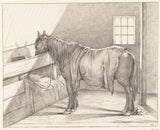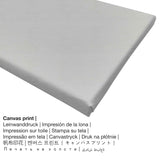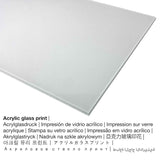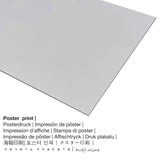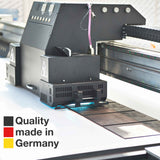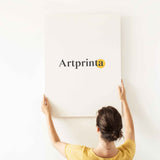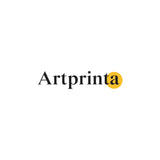Jean Bernard, 1812 - Ịnyịnya na-eguzo n'ụlọ ahịa, aka ekpe - ọmarịcha nka
Ụtụ gụnyere. Mbupu gbakọrọ na ndenye ọpụpụ.
Nkọwa ngwaahịa nka dị omimi
Standing horse in a stall, left is a masterpiece painted by the French onye na-ese ihe Jean-Bernard. Enwere ike ịhụ ihe osise na n'ime RijksmuseumNchịkọta nka. Site n'ikike nke - Rijksmuseum (nwere ikike - ngalaba ọha).Ezigbo nka nka bụ: . Ọzọkwa, itinye n'ọnọdụ odida obodo usoro na nwere akụkụ ruru nke 1.2: 1, nke na-egosi na ogologo bụ 20% ogologo karịa obosara.
Kedu ụdị akwụkwọ nka nka kacha amasị gị?
Anyị na-enye ụdị nha na ihe dị iche iche maka ngwaahịa ọ bụla. Ya mere, anyị na-enye gị ohere ịhọrọ n'ime nhọrọ ndị a:
- Mbipụta akwụkwọ mmado (akwa akwa akwa): The poster is a UV printed flat canvas with a slightly roughened surface structure. A printed poster is best suited for putting the art print with a custom-made frame. Please bear in mind, that depending on the absolute size of the canvas poster print we add a white margin between 2-6cm around the artwork, which facilitates the framing with your custom frame.
- Mbipụta iko acrylic (nke nwere ezigbo mkpuchi iko): A glossy acrylic glass print, often denoted as a print on plexiglass, transforms the original work of art into brilliant décor. Furthermore, the acrylic glass art print offers a good alternative to aluminium or canvas fine art prints. Your work of art is being made with the help of modern UV direct printing machines. With a glossy acrylic glass fine art print sharp contrasts as well as artwork details will be visible thanks to the very fine gradation in the picture. The acrylic glass protects your chosen art replica against light and external influences for many years.
- Aluminom dibond mbipụta (ọla): An Aluminium Dibond print is a print with an impressive depth - for a modern look and non-reflective surface structure. The colors of the print are luminous, details of the print are very clear. This direct UV print on aluminium is one of the most popular entry-level products and is a sophisticated way to display fine art reproductions, as it puts the viewer’s focus on the whole artwork.
- Mbipụta kanvas: A printed canvas, which shall not be confused with a canvas painting, is an image printed on a cotton canvas material. Also, a canvas makes a charming, appealing ambience. Hanging a canvas print: A canvas print has the advantage of being low in weight, which means that it is quite simple to hang your Canvas print without the use of additional wall-mounts. Hence, a canvas print is suited for any type of wall.
Legal disclaimer: We try everything in order to depict our art products as accurate as possible and to illustrate them visually in our shop. Still, the pigments of the print materials, as well as the imprint might differ marginally from the presentation on the monitor. Depending on your screen settings and the condition of the surface, not all color pigments will be printed as exactly as the digital version depicted here. Considering that all are printed and processed by hand, there may also be slight discrepancies in the exact position and the size of the motif.
Banyere ngwaahịa
| Nkewa edemede: | ọrụ mgbidi |
| Mmeputakwa: | dijitalụ mmeputakwa |
| Usoro mmepụta: | Mbipụta UV / dijitalụ |
| Mmalite nke ngwaahịa a: | emepụtara na Germany |
| Ụdị ngwaahịa: | a na-achọ |
| Ngwaahịa were: | nka mgbidi, ime ụlọ |
| Nhazi nke ihe nka: | nhazi odida obodo |
| Oke akụkụ: | 1.2: 1 ogologo: obosara |
| Akụkụ onyonyo pụtara: | ogologo bụ 20% ogologo karịa obosara |
| Akụrụngwa ị nwere ike ịhọrọ: | ígwè ebipụta (aluminium dibond), acrylic glass print (nwere ezigbo mkpuchi iko), mbipụta akwụkwọ mmado (akwụkwọ kwaaji), akwụkwọ akwa akwa. |
| Kanvas n'elu etiti ihe ndọtị (mbipụta akwa akwa): | 60x50cm - 24x20", 120x100cm - 47x39", 180x150cm - 71x59" |
| Acrylic glass print (nwere ezigbo mkpuchi iko) nhọrọ: | 60x50cm - 24x20", 120x100cm - 47x39" |
| Nhọrọ nha nke akwụkwọ mmado (akwụkwọ kwaaji): | 60x50cm - 24x20", 120x100cm - 47x39" |
| Nhọrọ ebipụta aluminom: | 60x50cm - 24x20", 120x100cm - 47x39" |
| ụba: | mbipụta nka na-enweghị isi |
Ozi ahaziri na nka
| Aha ọrụ nka: | "Standing horse in a stall, left" |
| Nhazi: | sere |
| Otu sara mbara: | nkà nke oge a |
| Century: | 19th narị afọ |
| Emepụtara na: | 1812 |
| Afọ nka: | karịa afọ 200 |
| Ụlọ ihe ngosi nka: | Rijksmuseum |
| Ebe ngosi nka: | Amsterdam, Netherlands |
| E Nwere na: | Rijksmuseum |
| Ụdị ikike nka: | ngalaba ọha |
| Site n'aka: | Rijksmuseum |
Tebụl nyocha nke onye na-ese ihe
| aha: | Jean-Bernard |
| Aha ndi ozo: | Jan Bernard, Bernard Jean, Bernard Jean II, Jean Bernard, Bernard Jan, Jean II Bernard |
| okike nke onye nka: | nwoke |
| Obodo onye nka: | French |
| Ọrụ: | etcher, drawer, eserese, watercolorist |
| Obodo obibi: | France |
| Otu nka: | omenkà nke oge a |
| Afọ ọnwụ: | 68 afọ |
| Afọ ọmụmụ: | 1765 |
| Ebe amụrụ onye: | Amsterdam, North Holland, Netherlands |
| Nwụrụ n'afọ: | 1833 |
| Ebe ọnwụ: | Amsterdam, North Holland, Netherlands |
© echebe nwebiisinka - Artprinta.com

